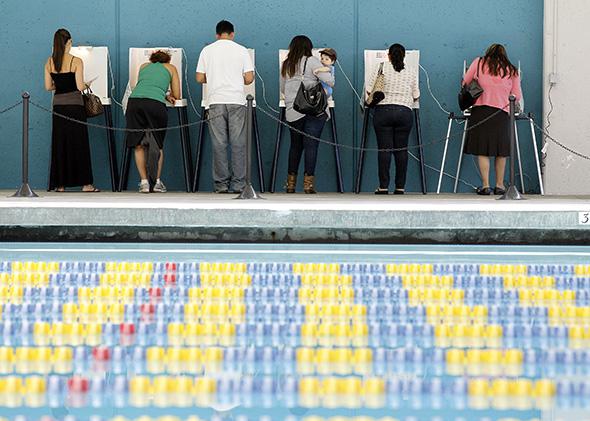If you had to describe Republican and Democratic Party coalitions in a single term, you could do worse than “stigmatized” versus “non-stigmatized.”
Core Democratic voters come from a host of marginal or formerly marginal groups: blacks, Latinos, Asians, single women, Jewish Americans, and LGBT Americans. By contrast, core Republican voters tend to belong to historically dominant groups, from middle-income and affluent workers and managers, to business owners and suburban whites.
But the distribution of stigma isn’t static over time. Through the 19th century and into the 20th, Democrats attracted Irish, Italian, and Eastern European immigrants and their descendants, until rising prosperity and mainstream integration brought them to the post–World War II Republican Party.
This dynamic—of stigma driving politics—still holds, and you see it in the broad picture of American life as well as in the details and the margins. In particular, says Syracuse political scientist Spencer Piston, skin color plays a strong part in partisan affiliation for Latino and Asian voters. Put simply, even after you account for education, age, income, and foreign birth, lighter-skinned Latinos and Asians are more likely to identify and vote Republican than their darker-skinned counterparts.
First, a few notes. Piston’s study doesn’t deal with black Americans, who are overwhelmingly Democratic in a way that isn’t true of any other group. Second, he relies on nationally representative data from the 2012 American National Election Studies and the 2008 Collaborative Multi-Racial Post-Election Survey. In the former, interviewers measured skin color, which can introduce substantial bias. As Piston notes, “It is possible that an interviewer’s estimate of a respondent’s skin color is influenced by the interviewer’s perceptions of the respondent’s political views—if, for example, the interviewer holds a stereotype that Obama supporters are dark-skinned.” For the latter survey, however, skin-color was self-reported, and interviews were conducted in Mandarin, Cantonese, Korean, and Vietnamese. It’s also true that, while Piston finds a real pattern, these are estimates—there’s a modest spread in how Republican lighter-skinned groups are versus darker-skinned ones.
With that said, the results are fascinating. On party identification, the difference between the darkest- and lightest-skinned Latinos is the difference between a strong Democratic partisan and a relative independent. For the 2012 Senate races, however, darker-skinned Latinos were much more likely to vote Democratic than lighter-skinned Latinos, who split their votes between the two parties. The differences are less stark for Asians, but they’re still noteworthy: Light-skinned Asians were less likely to vote Democrat in the 2008 national elections, and more likely to identify as independent or Republican.
Piston says it’s “striking that across two different ethnic groups, two national datasets, and two different modes of measuring skin tone, lighter-skinned individuals are more likely than dark-skinned individuals to prefer Republicans.” He’s right, and it’s a testament to the role skin color (and racism) can play in social integration.
In other words, while race defines the boundaries of broad disadvantage, skin color influences the relative position of people within them. As a group, blacks are disadvantaged in competition for jobs and other resources. But within the group, dark-skinned blacks are more likely to face job discrimination than light-skinned blacks, and—in terms of social perception—are more likely to seem “criminal.” The same dynamic applies to immigrants, regardless of racial or ethnic background: Darker-skinned immigrants suffer a wage penalty when compared to their lighter-skinned counterparts.
On the immediate question of political allegiance, data like this is more evidence for the need for humility in long-term political forecasts. We don’t know if minorities will make up the majority in the United States in 50 years, as many people predict. Given rates of intermarriage, it’s possible we’ll have a large population of people who are Latino and Asian in the same way that Italian Americans are Italian. And if we do become a “majority-minority” country, there’s no guarantee minorities will hold their Democratic allegiance.
But, regardless of how it looks, we’ll have a multiracial society. And this study—like others around color—raise larger questions of how it might develop over the next century. Indeed, if the strength and durability of color stigma is any indication, we might move to a country where we’ve eased the problems of racial discrimination, only to find ourselves—like our Latin American neighbors—in a new hierarchy of color prejudice.
